Running out of Rice, While Wasting Water
- By: "Farm Tender" News
- Dairy News
- Mar 29, 2020
- 877 views
- Share

Australia was once self-sufficient in rice. We now grow less than 25 percent of domestic rice consumption. The SunRice Group has been importing rice from Vietnam and repackaging it to make-up the shortfall. Since the Corona Virus pandemic, the Vietnamese government has banned the export of rice, while the Australian Bureau of Meteorology has feigned an unprecedented drought. There is a need to not only prioritise health needs, but also to ensure we can feed ourselves. This could go together with the restoration of the Murray River’s estuary.
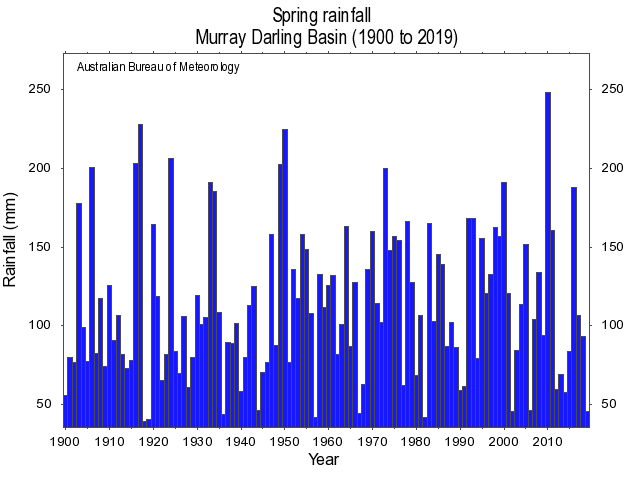
Spring rainfall in the Murray Darling Basin, 1900 to 2019.
I have been fortunate to live most of my life through the good times, and in a society so rich and well serviced that we flush our porcelain toilet bowls with water good enough to drink. At the same time, many have complained endlessly about a coming environmental apocalypse, unless all the travel stops, and we allocate ever more water to the environment. Now the travel has stopped, and also the rice growing, but not because of climate change or a shortage of freshwater.
We have a pandemic, and across the world communities have shown that they can do the right thing. Across the world, governments have put saving lives before capitalism and populations have mostly complied. We have been told to stay at home, and we mostly have. In Australia, department store giant Myer will closed from today. Around 10,000 staff will be stood down. Early last week, Qantas announced it was cancelling 90 percent of international flights. A couple of days later the borders were closed to everyone except Australians and Australian residents. My daughter was on the second last Qantas flight from the United States to Sydney, before the entire international Qantas fleet was grounded. She arrived the same day my home state of Queensland began turning back anyone who was not a resident, anyone who didn’t already live here.
She has spent the last few years overseas, most recently working in New York. She has told me that what was most disturbing about her last week there, in South Harlem Manhattan, was the surge in frequency of the sound of ambulance sirens.
New York has quickly become the global epicentre for Corona virus. A virus with its origins apparently in a seafood market in China that also sold wild animals kept alive in cages. Environmentalist Jane Goodall recently said that if anything good has already come from this virus, it is the closing down of that cruel trade. The market was in Wuhan which is a city on the Yangtzee River, where just a few years ago the Baiji went extinct. The Baiji was a grey dolphin endemic to the Yangtze River with tiny eyes and a long narrow beak. The last confirmed sighting was in September 2004.
The Baiji, Lipotes vexillifer, may be the first species of cetacean (whale, dolphin and porpoise) to go extinct in modern times. The extinction will have taken place at a time of unprecedented interest and concern for their large relative the Minke whale. It is perhaps a sad reflection of humanity’s sometimes inability to prioritise effectively on the basis of need, that so many resources and so much publicity has been devoted to ‘saving’ these whales whose populations are relatively abundant, while their endangered cousin was left to die out. In the same way we have been wasting water in the Murray Darling Basin on propping-up a crippled estuary when we could have been growing rice while restoring that estuary by bringing back the sea tides.
NO RICE IN THE SUPERMARKETS
Friday I was food shopping for my daughter now in a mandatory 14-day period of quarantine. I was surprised that there were no bags of standard rice on the shelves in my local Woolworths supermarket. Yesterday I went to Aldi specifically to buy some brown rice, but the line was so long – the line of people waiting just to enter that shop – that I will instead take her rice from my own pantry. Hopefully, the hoarding of food, as the Prime Minister, has described it, will stop. But is anyone in government a reliable source of information when it comes to claims there is enough rice to go around?
I phoned my friend Debbie Buller, who is a rice farmer on the Murrumbidgee River.
“There is no rice here, either,” she said. “Normally at this time of year we would be harvesting. But we have not been given a timely or adequate water allocation to grow rice for some years now.”
There have been claims that the recent drought was ‘unprecedented’, when in reality it was a very wet spring just a few years ago in 2016, in the Murray Darling Basin. Australia-wide the incident of drought has been decreasing since the 1970s and rainfall has generally been increasing. Yet since the summer of 2016-2017, rice growers have been denied a timely water allocation. The reservoirs and the rivers had enough water, but the government institutions responsible for water allocation have given Debbie very little. The mood has been against farming, and particularly against farming rice.
NO WATER FOR RICE GROWING
The Basin Plan has prioritised water for South Australia, and in particular the lower lakes that have been designated a wetland of international importance, even though they are only freshwater by artificial means since construction of the 7.6 kms of sea dyke back in the 1930s that stopped the tide.
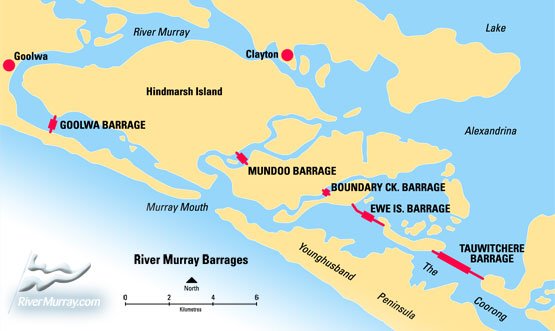
The sea dykes and barrages prevent inflows from the Southern Ocean, they have stopped the tides making Lake Alexandrina totally dependent on upstream reservoirs even during periods of drought.
The taxpayer-funded Basin Plan is meant to be about restoring the environment, but it ignores the first thing that should be considered when fixing a river system — that is the need to restore the estuary to its natural dynamic state, as I explained to a Senate Committee in December 2015.
The bottom-line is that successive governments have denied upstream irrigators water in an attempt to keep forcing what was once the Murray River’s estuary to remain as an artificial freshwater lake. The water from upstream storages is sent to South Australia and much of it lost to evaporation, including in transmission. The Lower Lakes, that were once a functioning estuary but now barraged in as entirely freshwater, lose in excess of 800,000 megalitres of fresh water each year in evaporation, water that could be used to grow rice and other important staple food crops.
If my good friend Debbie had just 2,000 megalitres (0.25%) of that water that is evaporated, she could grow 2.16 million kilos of rice on just 174 hectares (430 acres). This would go some way to returning us to self-sufficiency. Once upon a time, over the ten years to 2004, Australian rice farmers grew 1 million tonnes of rice in an average year; we were self-sufficient. In Australia we could easily grow enough rice to feed about 20 million people a meal of rice every day of the year. Instead, again this last summer there has been very little rice planted, and not nearly enough available in the Murrumbidgee or Murray River irrigation areas to restock the supermarket shelves.
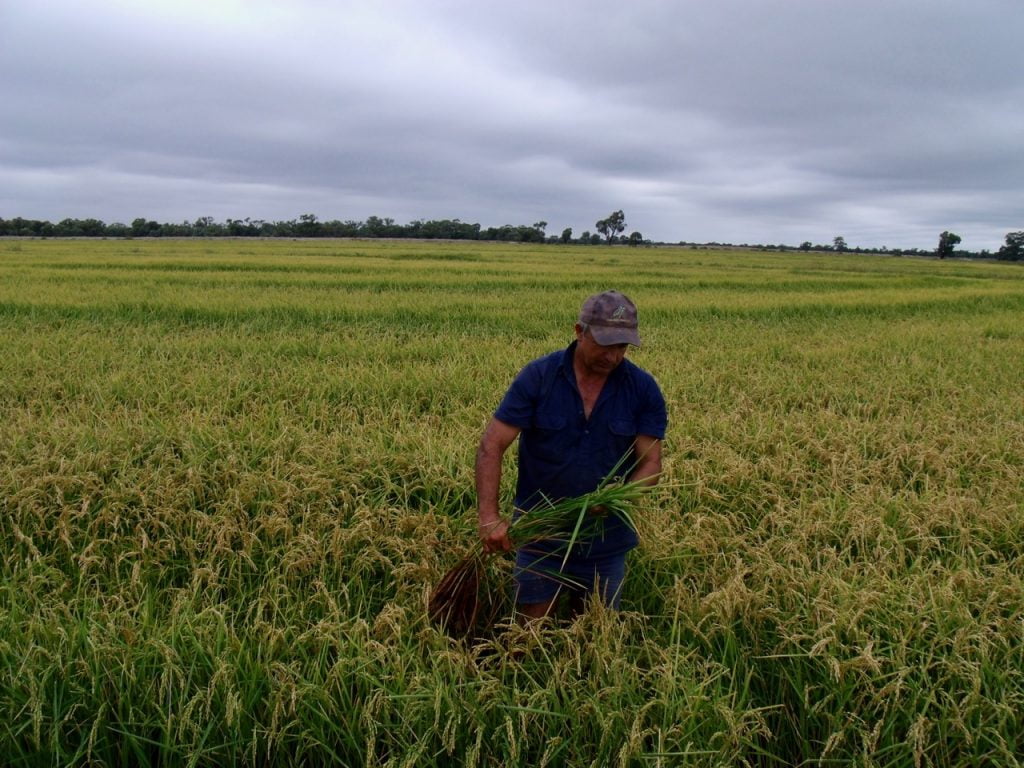
Another rice grower, my friend John Lolicato back in March 2011 when I visited him at Wakool, on an anabranch of the Murray River.
NO WATER, NO RICE, MILL CLOSED
A consequence was the virtual closure of the Deniliquin rice mill just last year, and the loss of 250 jobs.
To overcome the declining reliability of Australian grown rice because of changing government policy and public sentiment, the SunRice Group decided to instead invest in a mill where there was a reliable supply of rice.
They bought a rice mill in Vietnam with the intention of shipping the Vietnamese rice to Deniliquin for packing and distribution around Australia. Except, we live in unprecedented times, and the Vietnamese government has just banned the export of rice. So, the SunRice Group can no longer bring the Vietnamese rice back to Australia. There is not enough rice right now in Australia to restock the supermarket shelves, and none has been planted.
NEED FOR POLICY CHANGE, REMOVE THE SEA DYKES
Debbie and so many other rice growers would like to grow rice this next summer. But they have no idea whether they will be allocated any water. This situation needs to change. There is already more than enough water in the reservoirs for farming and the environment, if only the Murray River’s estuary were restored. The sea dykes need to be removed and the estuary restored. Then the 800,000 megalitres of water that is evaporated each year could be supplemented with saltwater, depending on the tides.
Once upon a time each spring, after good rains and snow melt, the Murray would tumble down from the Mountains spread over the vast Riverina and wind its way through the limestone canyons of the Riverland before flooding into Lake Alexandrina. By New Year, the river exhausted, and a breeze picking up from the southwest, the Southern Ocean would pour in through the Mouth of the river, and with the seawater came vast schools of Mulloway fish.
The fish came each autumn to spawn. The sea would work its way up across the lake and sometimes into the river proper. And so, the lakes would be sometimes fresh and sometimes salty, but always full of water and each autumn full of Mulloway.
Then the massive steel and concrete barrages were built across the Goolwa channel, that was after the dykes were already built sealing the Mundoo, Boundary Creek, Ewe Island channels and also the Tauwichere fishing area. In the autumn of 1940, the year the Goolwa barrages were completed and sealed, the Mulloway entered the Mouth, passed along the Goolwa channel and died in their hundreds of millions entrapped between the barrier and the falling tide.
The sea dykes killed the Mulloway fishery and crippled the estuary.
In 1939, the annual mulloway catch by commercial fishermen in the Murray River’s estuary was 595 tonnes. There is no longer an estuary; the Mulloway are stopped by the sea dykes. The catch in the adjacent Coorong has been no more than 30 tonnes in recent years.
The technical literature explains the sea dykes and Goolwa barrage reduced the size of the estuary by 89 per cent, and flows to the Murray mouth by 75 per cent. They stopped the tides. We are left with a freshwater lake full of carp instead of an estuary with Mulloway, crabs, waders and the biodiversity that comes when there is natural mixing of fresh and salt waters.
CONSEQUENCES OF HOLE DIGGING AND INFILLING
Some of us have been warning that as a civilization, it is best we not squander our wealth because bad things do happen. They are happening now. ‘Mr FOIA’, the sceptic and the good hacker who brought us Climategate, he warned back in 2009 that:
“[The] Wealth of the surrounding society tends to draw the major brushstrokes of a newborn’s future life. It makes a huge difference whether humanity uses its assets to achieve progress, or whether it strives to stop and reverse it.”
In the same email he described the misguided obsession with human-caused catastrophic global warming as “a massive hole-digging-and-filling-up endeavour”. The obsession has extended beyond climate change to so many aspects of natural resource management. It is the case that during the 1980 there were salinity issues in the Murray Darling Basin, caused in large part by rice farming. But the problems were solved through clever drainage management thirty years ago.
It is difficult to understand why this good news about environmental restoration is so rarely reported. Instead the Australian Broadcasting Corporation (ABC) continues to vilify those who defy agreed narratives when it comes to Australia’s longest river system, the Murray. Both sides of politics court the South Australian vote, and South Australians always want more freshwater including for the golf courses, wineries and the Goolwa sailing club that is just upstream of the barrage.
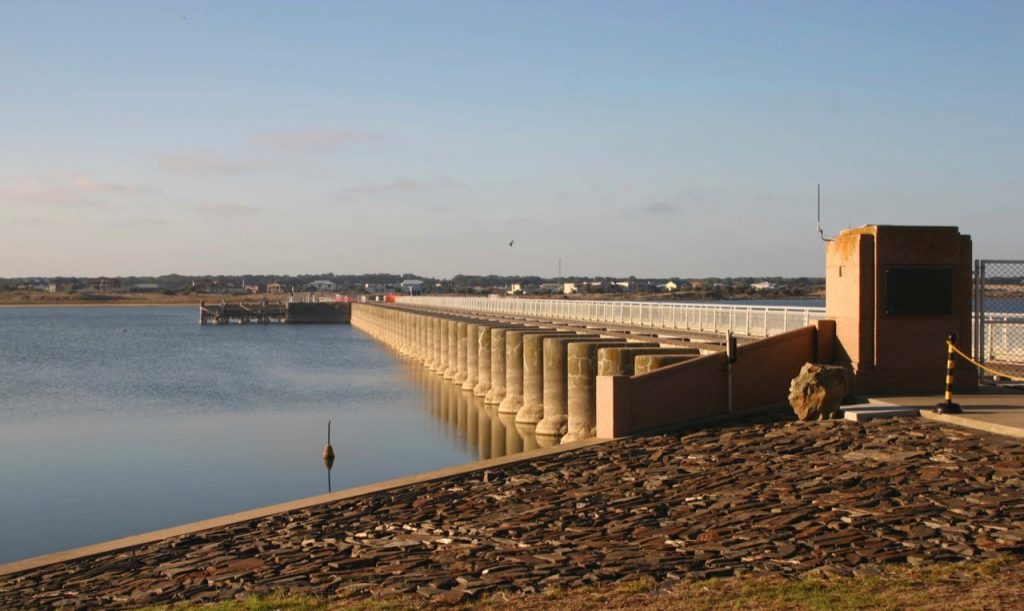
The Goolwa barrage that was sealed in early 1940, there are no longer any Mulloway fish in the Lower Lakes.
TIME TO SORT PRIORITIES
Now is the time to be honest to the evidence, to stop the waste, stop the politics and assure Debbie Buller some water for this summer, so she can grow rice for the thousands of people queuing for hours across Australia, trying to access staple food.
Denying Australian rice-growers water will not make it rain during drought, nor will it bring back the Yangtzee River dolphin or stop the spread of Corona virus. Restoring the Murray River’s estuary could though bring back the Mulloway fish. We are seeing for example in the many reports already of dolphins returning to Venice canals and clear skies over long-polluted cities, how resilient nature can be when we get out of the way.
On 11 March 2020, the World Health Organisation (WHO) declared a global pandemic, and the world community has responded closing whole industries including the travel industry. This health emergency could develop into a food emergency if we continue to hoard food, and if government policies continue to deny farmers access to water.
The SunRice Group have commenced discussions with the Australian government around the potential for an allocation of water to be made available to Australian rice growers who are upstream, this must be ahead of the planting window later in 2020 to ensure continued supply of Australian-grown rice for domestic consumption. Now is the time for sanity, for water to be allocated for farming so Australia can once again be self-sufficient in rice. But this is not enough, now is also the time to restore the once mighty Murray River its estuary.
The Chinese have banned the trade in exotic wildlife at that market in Wuhan. Now the Australian government can dismantle the 7.6 kilometres of sea dyke that deny the wild Mulloway their estuary. That would be a good start in getting out of the way, bring back the sea tide, and filling our supermarket shelves with rice.
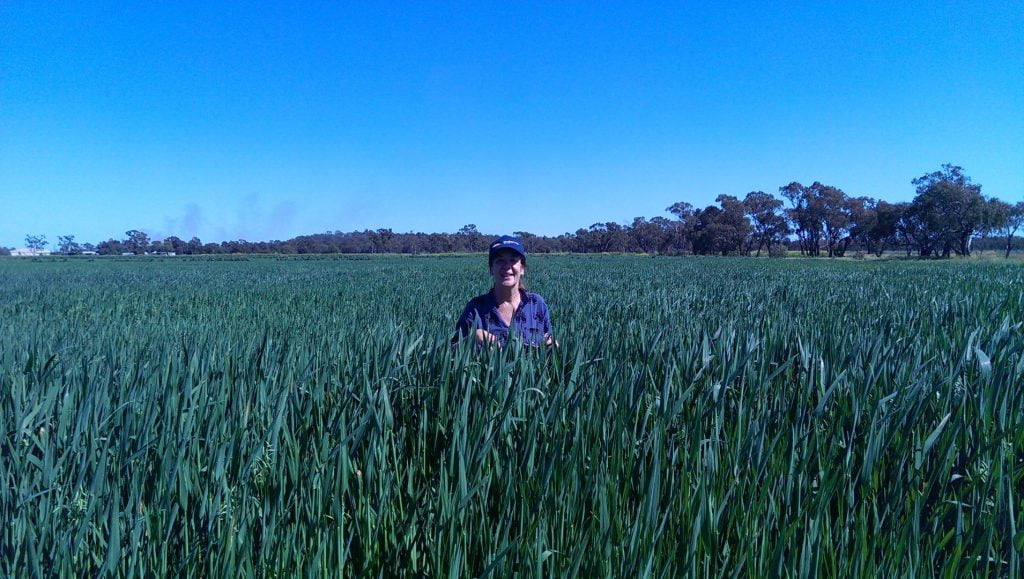
Debbie Buller standing neck-deep in a seed oat crop. It was planted directly after harvesting a rice crop, with the residual moisture producing high quality seed for oat farmers.
Picture - The feature photograph at the very top of this post is of Debbie Buller on her tractor in the Murrumbidgee Irrigation Area (MIA). This next spring she would so like to be planting rice.











Share Ag News Via